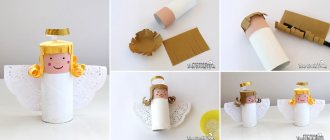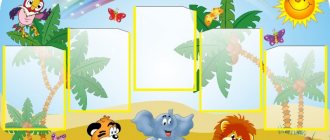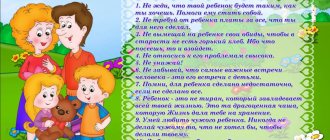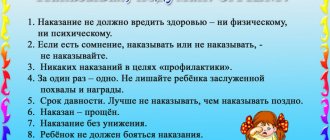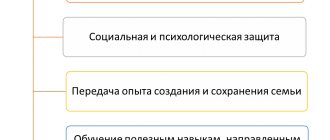Parents' club is an unconventional form of effective interaction between teachers and parents in preschool educational institutions
Plotnikova Anna Evgenievna
teacher
"Kindergarten No. 22"
Kamensk-Uralsky
Parents' club is an unconventional form of effective interaction between teachers and parents in preschool educational institutions
Brief description: experience in creating a family parent club in a preschool institution (group) for effective interaction with parents and an approximate annual work plan for the club will be interesting and useful for preschool teachers.
The family and kindergarten are the main institutions for raising a child. Public and family education of children should be a unified system of both educational and educational practices, implemented jointly by all participants in the educational process. The main goals should be: the formation of a moral, fully developed personality, ready for life in modern society. And every modern teacher faces the task of organizing effective interaction with the families of pupils, actively involving parents in the joint development of children in preschool educational institutions and families, developing uniform requirements, goals and objectives for the development of preschool children.
In this regard, each preschool educational institution uses different forms of work with families. Traditional and non-traditional forms of interaction with family can be distinguished. Traditional forms include:
- parent meetings,
- conversations, visiting families,
- joint holidays and entertainment,
- consultations,
- design of stands, travel folders with information for parents,
- exhibitions of family works, photo exhibitions,
- open days.
To non-traditional:
- conducting master classes,
- joint walks, entertainment, excursions on holidays and weekends,
- round tables, issues of family and group newspapers and posters,
- presentations
- video competitions,
- joint ICT presentations,
- production of brochures, leaflets, booklets,
- exhibitions of family heirlooms,
- creation and operation of a family club.
Today I want to share my experience of creating a family club in a kindergarten group. This is a wonderful opportunity to organize the most effective interaction between teachers and parents in a preschool institution.
The purpose of the family club: to create a unified educational process in the preschool educational institution and the family, the active involvement of parents in all activities of the kindergarten and group, effective interaction between adults and children.
Objectives of the Club:
- providing advisory, psychological and pedagogical education and assistance to parents,
- improving the pedagogical culture of parents,
- attracting parents to participate in the life of the preschool educational institution,
- creating conditions for full communication and cooperation between parents and teachers (exchange of opinions and experiences in family education).
Important conditions for the club to operate:
- making a joint decision to create a club at the first parent meeting,
- to captivate parents with an interesting direction (topic) for a year,
- determining the frequency of meetings (monthly, quarterly),
- drawing up a club work plan,
- meetings are held jointly with children and parents with the involvement of specialists.
I offer you a sample plan for the work of a club in a preschool institution in accordance with the annual / project theme.
Work plan of the family club “We are together”
Annual theme: “Getting to know your hometown”
| Deadlines | Event | Target |
| September | Family survey | Identifying the knowledge and ideas of parents and children about their hometown, its history, and the need for work in this area |
| First meeting “What do we know about our small homeland?” | To interest parents in the moral and patriotic education of children, creating conditions for joint acquaintance of children with their hometown | |
| October | Booklets on the most pressing requests of parents: “Family and computer”, “Child safety on the street”, “Reading together about our hometown” | Formation of parents' need to receive professional pedagogical assistance. |
| Photo exhibition “Walk through city attractions with mom (dad)” | Getting to know the sights of your hometown. make parents want to show their children historical places and monuments. | |
| November | Second meeting Creative workshop “Family Traditions” | Interaction between preschool educational institutions and families through familiarization with folk traditions of families |
| Mini-museum: “Craft Workshop” | Introduce children to the craft of their hometown. | |
| December | Preparation, rehearsals, participation in the New Year holiday | Invite parents to participate in the holiday in various roles of heroes |
| Competitions: "New Year's toy for the city tree" “New Year’s card “City Tale” "New Year's windows" | Joint participation in parent-child competitions | |
| Within six months | Excursions: Fire Department Museum Houses of Culture The city's attractions | Invite parents to go on city excursions together |
| January | Booklet for parents “What to tell and read to children about their hometown; Author’s poems about the city” | Recommendations from parents for introducing children to their small homeland. Introduce original poems by urban poets. |
| January | Mini-museum “My City” | Involve parents in joint creativity with children, creating models of city attractions from any materials, designing a mini-museum in a group |
| 3 meeting "Meeting interesting people" | Introduce city writers, leaders of creative and dance groups, famous people of the city | |
| February | Promotion "Igroteka" | Attracting parents' attention to children's play as an activity |
| Military-patriotic game "Zarnichka" | Invite fathers and grandfathers to participate in the dawn. | |
| Photo exhibition “Beloved Dad, Grandfather” | ||
| March | Spring holiday "March 8" | Involve parents in the preparation and holding of the spring holiday, decoration (Russian birch tree, Russian hut) |
| Photo exhibition “Walk with Mom in Hometown” | Invite parents to spend time together with their children | |
| April | 4 meeting Excursion - quest “Streets named after WWII heroes. Monuments to WWII participants" | Involve parents in a joint excursion to memorable places and jointly develop a route. |
| Book of Memory “Great feat through the eyes of children” | Create a Book of Memory about the participants of the Second World War. Introduce children to the history of grandfathers and great-grandfathers who participated in the Second World War. | |
| May | 5 meeting Creative living room "Living as one family" | Creating a social – pedagogical space for creative interaction between children and adults |
| Competition “Postcard to a Veteran” | Uniting children and adults during joint creativity. Foster a sense of respect for those who fought. | |
| Joint window decoration for May 1st and 9th | Creating a festive mood in the group through joint efforts and creativity | |
| During a year | Excursions to mom and dad's work | Invite parents to become familiar with enterprises and professions in their hometown |
| During a year | 6 meeting Participation in regional family competitions | Increasing the role of the family and the institution of family traditions |
| During a year | Weekend program (outing into nature, ski competitions, etc.) | Organization of joint leisure time for children and parents |
In conclusion: the influence of family on raising children is enormous. And success in the unified and integral education of the personality of each child depends on the organization of work with parents, their inclusion and involvement in the educational process, and effective interaction.
Parents' Club "School of Caring Parents"
So what should we do?
So that the children are happy?! (parents' answers).
The bell rings.
Change.
Let's play the finger game " Friendship"
» for the development of fine motor skills.
The girls and boys in our group are friends.
You and I will become friends little fingers.
Hello! (they say hello with each finger). (The bell rings).
Recommendations for parents. • Set the child in a positive mood. Instill in him that it is very cool that he has grown to the garden and become so big. • Do not leave him in the preschool group for the whole day right away, take him home as early as possible. Start visiting the preschool educational institution according to the algorithm proposed by experts. • Create a calm, conflict-free climate for him in the family. Spare his weakened nervous system. • Do not increase, but decrease the load on the nervous system. Stop going to public places and visiting for a while. Significantly reduce your television viewing. • Inform the doctor and caregivers about the baby’s personal characteristics as early as possible. • Do not bundle up your child, but dress him as necessary in accordance with the temperature in the group. Consult with the teachers, they will tell you how best to dress your child. • Create a routine for him on Sundays at home the same as in a child care facility. • Do not react to the child’s antics and do not punish him for his childish whims. • If a change in the child’s usual behavior is detected, contact a pediatrician or psychologist as soon as possible. • In case of severe neurotic reactions, leave the baby at home for several days and follow all the specialist’s instructions. Educator:
Dear Parents! Concluding my recommendations, I would like to draw your attention to a few points. Full adaptation of a child to kindergarten is possible no earlier than after 2-3 months. And during this entire period, care must be taken to ensure that the child does not feel too keenly the gap between his previous and present life. For example, try to dress him in familiar clothes for the first time, and give him his favorite toy to kindergarten. If a child is very bored, a photograph of his mother in the clothes closet or under the pillow of his crib can ease his condition; some small thing from his mother, for example, her scarf or handkerchief, can do the same.
Show as much interest as possible in his activities in kindergarten, listen carefully to his stories, save the drawings and applications that he brings; curiosity and the desire for action arise and develop (like the ability to speak or walk) with the benevolent and patient participation of adults, thanks to their constant encouragement. At first, a child may be very tired in kindergarten: new impressions, new friends, new activities, a large number of people. If a child comes home exhausted and nervous, this does not mean that his adaptation is difficult. It just takes time for the baby to get used to the new regime. Maintain relationships with your teacher and other parents. Be interested in who your baby is friends with, welcome and encourage friendship. Take part in your child’s life, rejoice in his successes and creativity.
Objectives of the family club
- to intensify the work of the institution with parents (legal representatives) of pupils, the creation of a social and pedagogical environment “child-kindergarten-family”;
- provide psychological and pedagogical assistance to parents (legal representatives) in creating a favorable psycho-emotional climate in children’s families;
- improve the psychological and pedagogical culture of parents;
- to form positive attitudes in raising children;
- harmonization of parent-child relationships;
- contribute to the establishment of trusting relationships between parents and kindergarten.
Thematic planning of the family club "Commonwealth"
| № | Topics of the meetings | Form of conduct | Term |
| 1 | Me and my child | Workshop | September |
| 2 | Happiness is when we are all together | Child-parent training | November |
| 3 | Play together | Joint activity between parents and children | January |
| 4 | We are together | Child-parent training | March |
| 5 | Learning to Express Anger | Joint activity between parents and children | May |
A set of materials on how a psychologist works with parents
The kit includes the family club "COMMONWEALTH" with notes of events + visual information for parents
MAGAZINE Preschooler.RF
Parents' club meeting on the topic “Being healthy is great!”Explanatory note
In the age of information and communication technologies, when parents are constantly overwhelmed by the flow of information, work, and everyday problems, they have almost no time left to read or listen to the teacher’s consultation, read information in the parent’s corner, or simply talk longer with the teacher about their child. Therefore, in our kindergarten, meetings with parents are interactive, educational in nature: short in time, voluminous in content. It depends on the teacher how fully the parent will remember the material offered to him, but the most important task is to find such words so that they will sink into the parent’s soul and heart for a long time, and make him think about his main role - raising his child.
In accordance with the Federal State Educational Standard for Preschool Education, one of the main principles of preschool education is the cooperation and interaction of the preschool educational institution with the family to ensure the full development of the child’s personality.
Cooperation is communication “as equals” , where no one has the privilege to indicate, control, or evaluate.
Interaction is a way of organizing joint activities that are carried out through communication.
Cooperation between teachers and parents allows you to get to know the child better, see him in different situations, and, therefore, help in understanding his individual characteristics, developing his abilities, and forming valuable life orientations.
To enhance the educational capabilities of parents, it is advisable for a teacher to use a variety of active forms of communication with them: discussion meetings, workshops, trainings, joint leisure activities for adults and children, folklore family evenings, educational and game quizzes, meetings of parent clubs and much more.
The joint activities of the teacher and parents contribute to the creation of a favorable climate in the family, the psychological and emotional comfort of the child in kindergarten and beyond.
Parents' club meeting on the topic “Being healthy is great!”
Goal: Building effective interaction with the families of pupils and increasing the competence of parents on the issues of maintaining and strengthening the physical and mental health of preschoolers.
Tasks:
- identification of key problems and factors influencing the health of children
- contribute to the creation of an emotionally favorable atmosphere in the family
- creating positive family education experiences
- promotion of healthy lifestyles.
Preliminary work: survey of parents on the topic of the parent club meeting, preparation of video material, cards “Harmful and Healthy Products” , teaching aid: “Answer the question” , development of a memo for parents, design of an announcement - invitation.
Participants: parents of the preparatory group, teacher.
Progress of the meeting:
Educator: Good evening, dear parents! I am glad to welcome you to the meeting of the parents' club. The topic of today’s meeting: “It’s great to be healthy!” At the beginning of our conversation, I want to ask: “Do you like cake?” (answers)
(there is a picture of a cake on the easel)
I suggest you bake a “Health Cake” . Do you agree?
A regular cake contains a variety of ingredients. We will look at the main components of a healthy lifestyle. What do you think is needed to keep our children healthy? (suggested answers)
Educator: Yes, you are right. Proper nutrition affects the health of our children.
And the first task for you. On the card with the picture of the products, mark the harmful products with a red tick.
Educator: So, we baked the first piece called “proper nutrition” and sent it to our cake.
(attach the “piece” to the cake)
Educator: You talked about playing sports, hiking, outdoor games, cycling and rollerblading. We will call all this “physical development” . And this is the next component of a healthy lifestyle.
Second task for you. Questions are hidden in plastic containers. I suggest you take one container at a time, read the question and answer it.
Questions:
- Continue the proverb: “If you want to be healthy -...” (toughen up)
- What weather can you go for a walk with your child? (any)
- The beginning of the path to the finish (start)
- It is the key to health (cleanliness)
- Likes to walk in the forest and sleep in a tent (tourist)
- This is not a tourist at all. Climbing up the mountain... (climber)
- I twist it with my hand, and on my neck, and with my foot,
- And I twist it around my waist, and I don’t want to drop it (hoop)
* To learn to swim faster, we need to go to... (swimming pool)
* Both from the wind and from the heat, It will protect you from the rain. How sweet it is to sleep in it! What is this? (tent)
* Bent over the river - Their agreement is this: The Okunka River will exchange her for a worm (fishing rod)
* In an open field near a birch tree, stripes are visible in the snow. The fox came closer: “Someone’s skis were running here.”
Educator: Physical education is good for health. By moving, the child actively develops and learns about the world around him.
And we put the next “piece” called “physical development” on the cake.
Parent: If we are talking about physical development, I suggest you do some exercises to relieve fatigue.
First exercise:
- Lower your chin as low as possible, slowly turn your head to the right and then to the left. Repeat the exercise 5 times in each direction.
- Place your palms together and quickly rub them together until you feel intense heat, then shake your relaxed hands 5 times.
- Close your eyes tightly for 5 seconds, then open them and mentally count to five (repeat the exercise 3 times).
- Rise up on your toes until your heels are about 1cm off the ground, then lower to the floor. Repeat this shaking 5-6 times.
Educator: Thank you (parent’s name), we will definitely do these exercises. I hope you got some rest? And we continue. You talked about taking walks in the fresh air. But in order to have fresh and clean air, we all need to protect the environment. How do you teach children to take care of the world around them from personal experience? (parents' answers)
Educator: We, in kindergarten, also pay great attention to environmental education. Our children know that environmental protection is one of the global problems of our state. You know that our group recently completed a quest - the game “Young Ecologist” . I bring to your attention a fragment of this quest (video fragment).
Educator: So, we also place the next “piece” - “environment” on our cake.
Educator: Our cake is almost ready. One component is missing. What else do you think can affect the health of our children? (if parents find it difficult to answer, the teacher comes to the rescue)
If a child is smiling, talkative, friendly, and easily makes contact with people around him, this is an emotionally prosperous child. So what do we call the last piece? ( "emotional well-being" )
Educator: and now, I suggest you watch the social video “Find time for me!” .
Educator: In the midst of the daily bustle, don’t forget - hug your child, tell him that you love him! (the teacher places the last “piece” - “emotional well-being” )
Educator: Our cake is ready. Let's all name its components together.
Educator: I recently read the parable “Four Candles” . And I want to tell you about it.
“Four candles burned calmly and slowly melted. There was such silence that you could hear them talking.
The first one said:
- I am Calm... Unfortunately, people don’t know how to keep me. I think I have no choice but to go out!
And the light of this candle went out.
The second one said barely audibly:
- I am Vera... Unfortunately, no one needs me. Therefore, there is no point in me burning further.
As soon as she fell silent, a light breeze blew and extinguished the candle.
The third candle became sad:
- I am Love... I no longer have the strength to maintain my flame. People don’t appreciate me and don’t understand me,” she said and went out.
Suddenly a child entered the room and, seeing three extinguished candles, began to cry in fear:
- What are you doing!? You must burn - I'm afraid of the dark!
The fourth candle said:
- Don't be afraid and don't cry! While I'm burning, I can always light the other three candles. After all, I am Hope.”
Educator (lights three extinguished candles): So let's not extinguish the fire of peace, love and faith in our hearts, and hope will help us.
Reflection.
Educator: Tell us about your impressions. What did you like? What were you missing?
Educator: Allow me to announce the decision of our meeting:
Whether you want it or not, But the point, comrades, is that, first of all, we are parents, And everything else comes later!
Educator: And at the end of our meeting, I want to give you a “reminder” - “Always remember...”
| Next > |

